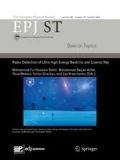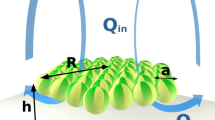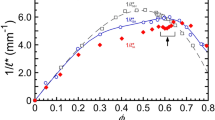Abstract
When droplets are tightly packed in a 2D microchannel, coalescence of a pair of droplets can trigger an avalanche of coalescence events that propagate through the entire emulsion. This propagation is found to be stochastic, i.e., every coalescence event does not necessarily trigger another. To study how the local probabilistic propagation affects the dynamics of the avalanche, as a whole, a stochastic agent-based model is used. Taking as input, (i) how the droplets are packed (configuration) and (ii) a measure of local probabilistic propagation (experimentally derived; function of fluid and other system parameters), the model predicts the average size distribution of avalanches. In this article, we investigate how droplet configuration affects the avalanche dynamics. We find the mean size of these avalanches to depend non-trivially on how droplets are packed together. Large variations in the avalanche dynamics are observed when droplet packing are different, even when the other system properties (number of droplets, fluid properties, channel geometry, etc.) are kept constant. Bidisperse emulsions show less variation in the dynamics and they are surprisingly more stable than monodisperse emulsions. To get a systems-level understanding of how a given droplet-configuration either facilitates or impedes the propagation of an avalanche, we employ a graph-theoretic analysis, where emulsions are expressed as graphs. We find that the properties of the underlying graph, namely the mean degree and the algebraic connectivity, are well correlated with the observed avalanche dynamics. We exploit this dependence to derive a data-based model that predicts the mean avalanche sizes from the properties of the graph.




Similar content being viewed by others
Data availability statement
No data are associated in the manuscript.
References
N. Bremond, H. Doméjean, J. Bibette, Propagation of Drop Coalescence in a Two-Dimensional Emulsion: A Route towards Phase Inversion. Phys. Rev. Lett. 106(21), 214–502 (2011). https://doi.org/10.1103/PhysRevLett.106.214502
D.Z. Gunes, X. Clain, O. Breton, G. Mayor, A.S. Burbidge, Avalanches of coalescence events and local extensional flows-stabilisation or destabilisation due to surfactant. J. Colloid Interface Sci. 343(1), 79–86 (2010). https://doi.org/10.1016/j.jcis.2009.11.035www.ncbi.nlm.nih.gov/pubmed/20031149
M. Danny Raj, R. Rengaswamy, Coalescence of drops in a 2D microchannel: critical transitions to autocatalytic behaviour. Soft Matter 12(1), 115–122 (2016). https://doi.org/10.1039/C5SM01915Jhttp://xlink.rsc.org/?DOI=C5SM01915J
M. Danny Raj, R. Rengaswamy, Interacting coalescence avalanches in a 2D droplet assembly. AIChE J. 00(0), aic.16,465 (2018). https://onlinelibrary.wiley.com/doi/abs/10.1002/aic.16465
J.C. Baret, F. Kleinschmidt, A.E. Harrak, A.D. Griffiths, Kinetic aspects of emulsion stabilization by surfactants: a microfluidic analysis. Langmuir 25(11), 6088–6093 (2009). https://doi.org/10.1021/la9000472
L. Frenz, K. Blank, E. Brouzes, A.D. Griffiths, Reliable microfluidic on-chip incubation of droplets in delay-lines. Lab Chip 9(10), 1344–8 (2009). https://doi.org/10.1039/b816049jwww.ncbi.nlm.nih.gov/pubmed/19417899
J. Dai, H.S. Kim, A.R. Guzman, W.B. Shim, A. Han, A large-scale on-chip droplet incubation chamber enables equal microbial culture time. RSC Adv. 6(25), 20516–20519 (2016). https://doi.org/10.1039/C5RA26505C. (pubs.rsc.org/en/Content/ArticleLanding/2016/RA/C5RA26505C xlink.rsc.org/?DOI=C5RA26505C)
D.Y.C. Chan, E. Klaseboer, R. Manica, Film drainage and coalescence between deformable drops and bubbles. Soft Matter 7(6), 2235 (2011). https://doi.org/10.1039/c0sm00812e. (xlink.rsc.org/?DOI=c0sm00812e)
PJa. Janssen, P.D. Anderson, Modeling film drainage and coalescence of drops in a viscous fluid. Macromol. Mater. Eng. 296(3–4), 238–248 (2011). https://doi.org/10.1002/mame.201000375
I.U. Vakarelski, R. Manica, X. Tang, S.J. O’Shea, G.W. Stevens, F. Grieser, R.R. Dagastine, D.Y.C. Chan, Dynamic interactions between microbubbles in water. Proceedings of the National Academy of Sciences of the United States of America 107(25), 177–82 (2010). https://doi.org/10.1073/pnas.1005937107. http://www.pubmedcentral.nih.gov/articlerender.fcgi?artid=2895070&tool=pmcentrez&rendertype=abstract
N. Bremond, A.R. Thiam, J. Bibette, Decompressing Emulsion Droplets Favors Coalescence. Phys. Rev. Lett. 100(2), 024,501 (2008). https://doi.org/10.1103/PhysRevLett.100.024501
N. Xu, J. Blawzdziewicz, C. O’Hern, Random close packing revisited: ways to pack frictionless disks. Phys. Rev. E 71(6), 061,306 (2005). https://doi.org/10.1103/PhysRevE.71.061306
K.W. Desmond, E.R. Weeks, Random close packing of disks and spheres in confined geometries. Phys. Rev. E 80(5), 051,305 (2009). https://doi.org/10.1103/PhysRevE.80.051305
K.W. Desmond, E.R. Weeks. Code: To generate randomly closed packed discs (2009). http://www.physics.emory.edu/faculty/weeks/ken/ConfinedRCP.html
Y. Yoon, A. Hsu, L.G. Leal, Experimental investigation of the effects of copolymer surfactants on flow-induced coalescence of drops. Physics of Fluids 19(2), 023,102 (2007). https://doi.org/10.1063/1.2409735. http://link.aip.org/link/PHFLE6/v19/i2/p023102/s1 &Agg=doi
J.W. Ha, Y. Yoon, L.G. Leal, The effect of compatibilizer on the coalescence of two drops in flow. Physics of Fluids 15(4), 849 (2003). https://doi.org/10.1063/1.1555803
M. Danny Raj, R. Rengaswamy, Averaged model for probabilistic coalescence avalanches in two-dimensional emulsions: Insights into uncertainty propagation. Phys. Rev. E 95(3), 032,608 (2017). https://doi.org/10.1103/PhysRevE.95.032608
S.M. Ross, Introduction to Probability Models (Academic Press, New York, 2014)
M. Newman, Networks: An Introduction, 1st edn. (New York, NY, Oxford, 2010)
D.A. Spielman, in 48th Annual IEEE Symposium on Foundations of Computer Science (FOCS’07) (IEEE, 2007), pp. 29–38
The conductance of a given cut of a graph is defined as the ratio of the number of edges across the cut to the number of edges within the smaller side of the cut. The conductance of the whole graph is the maximum value of conductance over all cuts. [23] Computing the conductance of a graph is an NP-hard problem
D. Spielman, Spectral graph theory. Combinatorial scientific computing 18 (2012)
B. Bollobás, Modern graph theory, vol. 184 (Springer, New York, 1998)
Acknowledgements
This project was funded by the DST INSPIRE faculty award, grant number: DST/INSPIRE/04/2017/002985. DRM acknowledges the technical assistance from Bhavya Balu and the discussions with Raghunathan Rengaswamy at IIT Madras, in the early stages of the project. We would like to thank Nicholas Bremond (LCMD-ESPCI, France) for giving us the permission to use the snapshots from his unpublished videos (Fig. 1A (i), (ii)–(v)).
Author information
Authors and Affiliations
Corresponding author
Rights and permissions
Springer Nature or its licensor (e.g. a society or other partner) holds exclusive rights to this article under a publishing agreement with the author(s) or other rightsholder(s); author self-archiving of the accepted manuscript version of this article is solely governed by the terms of such publishing agreement and applicable law.
About this article
Cite this article
M, D.R., Sivakumar, P. & Nabeel, A. Inferring the stability of concentrated emulsions from droplet configuration information. Eur. Phys. J. Spec. Top. 232, 893–900 (2023). https://doi.org/10.1140/epjs/s11734-022-00705-4
Received:
Accepted:
Published:
Issue Date:
DOI: https://doi.org/10.1140/epjs/s11734-022-00705-4




